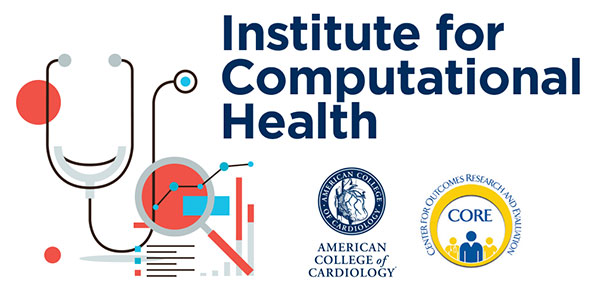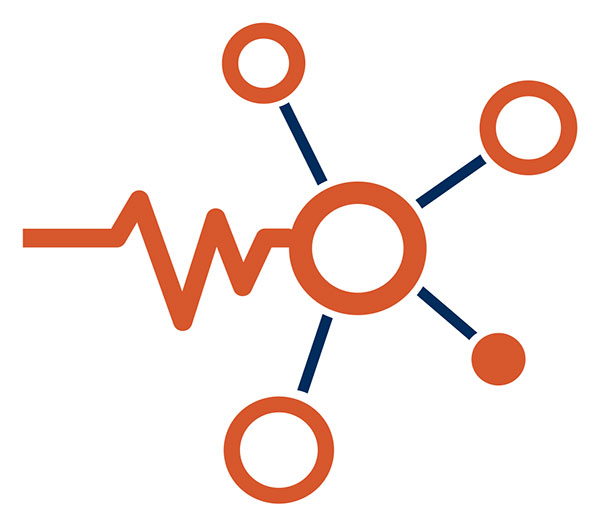Feature | Math, Computers and Cardiovascular Care: How Computational Health Can Push the Boundaries of Medicine

The ACC and the Yale-New Haven Hospital’s Center for Outcomes Research and Evaluation (YNHH/CORE) recently announced the formation of the Institute for Computational Health (ICH), a joint initiative intended to accelerate the application of advanced computational methods to medicine and health care.

Outside of health care, advanced computational methods such as machine learning and artificial intelligence (AI) have led to remarkable analytical breakthroughs in areas such as retail and entertainment. The ACC and YNHH/CORE realized early that these methods could have profound implications for medicine and health care, particularly as the U.S. and other global health care systems digitized terabytes of clinical information with little strategy for how it might be analyzed and applied.
“I believe data science is going to contribute to more medical breakthroughs in the next 10 years than everything else combined,” declares Harlan M. Krumholz, MD, SM, FACC, director of YNHH/CORE and professor of medicine at Yale University, not one to shy away from bold predictions. “If we are successful, the Institute for Computational Health will be at the forefront of this effort. Computational health ultimately represents a new frontier in health care where mathematical and computational empiricism will underpin a much broader swath of medical decision-making. The current hype does not match the accomplishments in this area — at least not yet — but I believe we will get there.”
A Little Perspective From the Birth of Modern Science
Talk of the information or computational revolution is now so cliché that it’s hard to put it into any real perspective. Yet you can’t spend much time with machine learning or AI researchers, including those at the ICH, before you realize this isn’t your old college math. In fact, according to many applied mathematicians, the techniques necessary to make sense of massive new data sets probably weren’t even invented when you were in college.
To put this in perspective, it’s worth making a historical analogy to the birth of modern astrophysics and math. Over the course of about 150 years in the 16th and 17th centuries, the efforts of Copernicus, Galileo, Kepler and finally Newton overturned the geocentric theory of the universe that had been the common understanding of reality since then. What tends to be lesser known are the contributions of the late 16th century Dutch astronomer Tycho Brahe, whose meticulous astronomical observations provided the data set on which Kepler and Newton worked out their mathematical laws. READ MORE.
The overarching vision of ICH is to apply advanced computational techniques to large health-related data sets with the goal of providing information to improve health care delivery and health outcomes — what the team at the ICH calls computational health. While this vision will evolve over time, there is cautious optimism it could transform the theoretical promise of the medical big data revolution into practical, everyday solutions that will benefit individual patients and their communities.
Key to this vision is the ICH’s pragmatic and inclusive philosophy, a relative rarity in the data science field: all of its work is done in a collaborative, multidisciplinary fashion that includes practicing clinicians and patients from the very beginning. This ensures that the unique skills of the ICH data scientists — including medical informatics, computer science, applied math, biostatistics and engineering — remain focused on the tangible needs of patients and their caregivers. This is a group that is deeply committed to improving health, not just publishing papers.
“The opportunity is unprecedented,” says John Rumsfeld, MD, PhD, FACC, ACC Chief Innovation Officer. “If you put the best people equipped with the most advanced mathematical techniques to work on the largest cardiovascular data sets in the world, can you make real progress? For example, if new data sources on social behavior can be assessed, can we better tease apart the role society plays in peoples’ health and promote new health interventions?”
"I believe data science is going to contribute to more medical breakthroughs in the next 10 years than everything else combined. … Computational health ultimately represents a new frontier in health care where mathematical and computational empiricism will underpin a much broader swath of medical decision-making." — Harlan M. Krumholz, MD, SM, FACC
Initial ICH efforts are applying the computational techniques YNHH/CORE is known for, as well as the robust data from ACC’s NCDR registries. “Just in the outpatient setting, we receive clinical data from over 470,000 ambulatory visits each week in our programs,” says Frederick Masoudi, MD, MSPH, FACC, chair of the NCDR Management Board. “We’ve learned how to manage this volume of data over the last 20 years; but through ICH we can employ these data in completely new ways that will help patients and support ACC members.”
Leveraging the ability of machine learning models to digest much richer data sets is where the ICH team originally started — re-examining the accuracy of traditional risk-prediction models for complications like acute kidney injury and periprocedural bleeding, as well as in-hospital mortality, and seeing if they can be improved upon by using additional variables in a more natural state. This set up also allows for further analysis of how and why new techniques may be better and what mathematically enables the improvement.
In its first major clinical study, on acute kidney injury after PCI, now undergoing peer review, the ICH team found that novel machine learning approaches performed significantly better than traditional regression models. While the overall results are not enough to be considered a breakthrough, researchers did find the component grouping of patients by risk was substantially improved, meaning that patients were much more accurately classified by their personal, individualized risk. This result could have major implications for bedside practice and is now the focus of a small upcoming study to apply the new models at Yale-New Haven Hospital.
It’s early results like this that fire the imagination of those involved with ICH. Understanding how computational advancements contribute to modest discoveries right now potentially sets the stage for much bigger changes in the cardiovascular medicine of the future.
Math is not new in medicine nor are the predictive clinical models it fuels. Statistical techniques have long been used in observational studies and clinical trials to control for what scientists call confounders, factors that may influence the outcome other than the factor being tested. Of course, the ultimate control for confounders is randomization, the scientific bedrock used in clinical trials. But instead of seeing all the statistical noise in an average study as a nuisance, the new math welcomes that heterogeneity as the source code for patient-level phenotyping.
It is the variation among patients that now makes them interesting. And the more variation that exists in the source data, assuming the number of observations is large enough, the more possible it will be to tease apart the effects these characteristics are having on each other and the patient’s health. Until recently, limits on computational power and statistical methods forced many researchers to simplify their data.
Missing Data: No Escaping the Math

When it comes to missing clinical data, especially unknown unknowns, there’s no escaping the math. But let’s start with the punch line first so we know where we’re headed. The principal power of advanced computational techniques is the ability to automatically identify and account for higher level interactions between explanatory variables and the outcome variable.
Modeling the higher order interactions leaves us less dependent on missing variables because the overall cohesion of the model is less dependent on any given variable. In effect, the model still knows the value of the missing data even if we don’t. And this works regardless of whether the data are missing from a known variable or an unknown variable.
It is this mathematical cohesion in the face of clinical data incompleteness that opens the door to applying these models in the messiness of the real world and exploring novel relationships in otherwise understudied disease. READ MORE.
The data were easier to work with, but it also lost information. As such, patients with complex diseases that express themselves along continuums, like diabetes or hypertension, are characterized as either having the disease or not for the purposes of research. Clinicians have long known that a patient with an Hba1c of 6.4 percent is not materially different than a patient with 6.5 percent, even though the latter is diagnosed as having diabetes and the former not. On the other hand, there is a big clinical difference between a patient with an HbA1c of 6.5 percent and one with 9 percent. The dichotomous coding of diabetes misses both.
The same could be said for the arbitrary cutpoints used to define high blood pressure and dyslipidemia. The fact is that the simple distinction between disease and health is starting to blur. Traditional yes/no diagnosis may still serve as a practical clinical or social construct, but for the purposes of advanced computational science, full fidelity data are much preferred.
Krumholz pushes this thinking even further. “The enhanced accuracy of the patient-specific prediction is important, but if you look closer, the findings of these early studies suggest we’re on to something bigger,” he says. “They suggest we can start to solve problems in the clinical practice of medicine that have been vexing us for decades by moving away from averages and more toward precise prediction.”
The way Krumholz and his team see it, there are two big barriers to precision medicine in cardiology right now: 1) the current state of electronic health records (EHRs); and 2) lack of evidence on so many conditions.
While EHRs are acceptable when a specific clinician is working with a specific patient, their lack of consistent structure and rampant incompleteness are substantial barriers to systematic use. For this reason, almost all clinical trials, observational studies and clinical registries require tedious and expensive manual data abstraction. This renders the data dramatically more complete, accurate and consistently structured — a friendlier environment to build clinical prediction models.
But the problem, of course, should be obvious: once built and validated, no matter how powerful, the prediction models cannot be easily used back in the real clinical world. There is no consistently structured data over which to run them. And through the course of the typical abstraction, the patients are incompletely described.
"Just in the outpatient setting, we receive clinical data from over 470,000 ambulatory visits each week in our programs. We’ve learned how to manage this volume of data over the last 20 years; through ICH we can employ these data in completely new ways that will help patients and support ACC members." — Frederick Masoudi, MD, MSPH, FACC
Even in an area as thoroughly studied as cardiology, major conditions, such as heart failure with preserved ejection fraction and Type II myocardial infarction, are not supported by an evidence base to generate guideline recommendations. Closing the knowledge gaps anytime soon using our current methods is unlikely given the clinical trials necessary would be too big, too complicated and too expensive.
The data to make progress on these two problems are out there, however, and the ICH team thinks they can get it and make sense of it. Newly developed technologies like AI-powered natural language processing (NLP) harness enormous computing power to do things that simply weren’t possible a few years ago. Additionally, our ability to store and process data now exists at a scale unheard of before. The rise of self-documentation on social media also offers the potential for new sociodemographic data sets and insights to address the effect of the ambient environment on health, provided they are used properly.
“People aren’t healthy or sick in isolation,” says Rumsfeld. “Where they live, how they work and play, their education, social class, ethnicity and race, all impact their health. For perhaps the first time we have the potential to evaluate more traditional medical data alongside novel data sources such as social determinants of health, genomics, digital health data and patient-reported outcomes.”
Collectively, each of these factors, as well as others, enable researchers to take precision medicine models out of the laboratory and start studying them in the real world, focusing on practical utility to doctors and patients and not worrying excessively about the imperfection inherent in medical data. They also provide the necessary new tools to study the great understudied conditions of cardiology, hopefully leading to new hypotheses and treatments that can then be tested in controlled trials.
"People aren’t healthy or sick in isolation. Where they live, how they work and play, their education, social class, ethnicity and race, all impact their health. For perhaps the first time we have the potential to evaluate more traditional medical data alongside novel data sources such as social determinants of health, genomics, digital health data and patient-reported outcomes." — John Rumsfeld, MD, PhD, FACC
What does any of this have to do with the ACC? What’s in it for cardiovascular professionals who are buffeted daily by changing payment models, integration with hospitals, new administrative hurdles to access drugs and tests, and the minute-to-minute focus needed to save patients in the throes of a heart attack?
 ACC President C. Michael Valentine, MD, FACC
ACC President C. Michael Valentine, MD, FACC Richard A. Chazal, MD, MACC
Richard A. Chazal, MD, MACC
ACC President C. Michael Valentine, MD, FACC, takes the long view: “In the 1960s we were pioneering cardiovascular education around the world; in the 1970s we were deeply involved in the percutaneous revolution; by the 1980s we were inventing guidelines; the 1990s brought clinical registries; and in the 2000s the College led the way with national quality improvement campaigns, appropriate use criteria and clinical apps. At every stage there were members who struggled to understand how these innovations would be relevant to them. The ACC must focus on the current concerns of members, while leading in the same manner as we have over the past decades and investing in the future so we’re solving the problems of tomorrow.”
Richard A. Chazal, MD, MACC, past president of ACC and chair of the member work group that oversees the ACC innovation agenda, seconds this view. According to Chazal, this look to the future is why ICH is so important and why it is one of the bedrock programs of ACC’s innovation agenda. “We are working with a number of fascinating tech startups, many of whom strive to utilize machine learning or AI. While exciting, the fact remains that almost all of this type of application remains untested in a clinical environment. Further, when studied in trials, the actual computational mechanics generally remain shrouded in a black box. ICH gives us the academic partnership to make certain that we understand how these technologies work, not just what they do. That’s part of our responsibility to our patients and to society.”
The Institute for Computational Health is actively seeking partners with which to grow its academic and applied work. Interested parties should contact ACC Executive Vice President Brendan Mullen at bmullen@acc.org.

This article was authored by J. Brendan Mullen, Executive Vice President, American College of Cardiology.
Keywords: ACC Publications, Cardiology Magazine, Academies and Institutes, Acute Kidney Injury, Artificial Intelligence, Biometry, Biostatistics, Caregivers, Diabetes Mellitus, Diet, Disease Management, Documentation, Dyslipidemias, Electronic Health Records, Empiricism, Genomics, Genotype, Global Health, Glycated Hemoglobin A, Goals, Habits, Heart Diseases, Heart Failure, Hospital Mortality, Hypertension, Imagination, Information Storage and Retrieval, Immune System, Myocardial Infarction, Natural Language Processing, Outcome Assessment, Health Care, Outpatients, Peer Review, Percutaneous Coronary Intervention, Quality Improvement, Random Allocation, Registries, Smoking, Social Behavior, Social Class, Social Determinants of Health, Social Media, Stroke Volume, Universities, Verbascum
< Back to Listings


